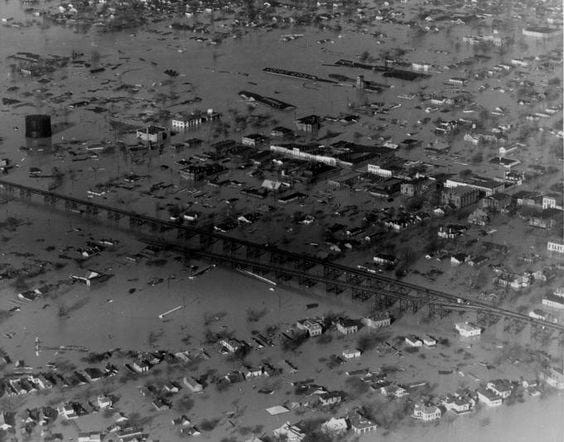The Flood They Would Never Forget (Start Here)
Introducing The 1937 Flood Journal.
Hello, I’m Neil Sagebiel, an author and writer. Thank you for reading these first words of The 1937 Flood Journal.
I’m also the great grandson, grandson, grand nephew, nephew and son of flood survivors.
Some of my earliest memories are of sitting in the homes of my relatives on visits to Jeffersonville, Indiana, an Ohio River town across from Louisville, Kentucky.

During conversations in living rooms and kitchens, I would hear family members mention “the flood” as if it happened last week.
The flood? It was a mystery to me as a boy. As I would learn, the flood had a permanent spot in the family lexicon.
The flood was a life-changing event, and one that drew a hard line through the year 1937. “That happened before the flood” or “that happened after the flood,” my elders would say in the months, years and decades that followed early 1937.
Floods — especially spring floods — were commonplace on the Ohio River. In the course of their lifetime, my family and thousands of people along the nearly thousand mile river saw innumerable floods. But the Great Flood of 1937, as it came to be known, was simply “the flood” to the people who survived it.
On February 14, 1937, this snippet of conversation appeared in The Courier-Journal, a Louisville newspaper:
“The only flood I ever saw,” said an old man.
“Just move here?” asked a visitor.
“No, lived here all my life. Went through five high waters, but this is my first flood.”
In the aftermath of the 1937 flood, the Red Cross reported, “Undoubtedly, next to the World War it was from the standpoint of human suffering, destruction of property and cost, the worst disaster in the history of the nation.”
Seventy-five years after the ‘37 deluge chased more than a million people from their homes, historian David Welky called it “the worst river flood in American history.”
The waters receded, but not the memories.
My father talked about the flood up until his death in 2021 at the age of 94. Nine years old when the muddy water entered his small house near the earthen levee, the flood changed his address and changed his life.
Here at The 1937 Flood Journal, I’ll share what my dad told me, but also much more. What began for me as a family story has grown far beyond what I knew or could imagine. As I’ve found in my travels from points in West Virginia to where the Ohio meets the Mississippi in Cairo, Illinois, there are extraordinary flood accounts all along the winding river.
I’ve discovered them in hand-written diaries, oral histories, family letters, a variety of journals and publications, radio broadcasts, small-town newspapers and major dailies, national magazines, grainy black-and-white photographs and more.
I look forward to sharing my family’s story and other untold stories about surviving the flood, including the people and the places, the rescues and the holdouts, and the tragedies and the absurdities.
Please come along. It will be something.
FRIED BOLOGNA: Family Stories from the American Midwest and Upland South Join me for stories about my ancestors who lived, worked and traveled in the hills and along the rivers of Arkansas, Illinois, Indiana, Iowa, Missouri and beyond.




I'm intrigued with this story and your connection to so many of the survivors, and I look forward to reading your other posts. When I saw the title of your publication, I thought sure it would be the same flood as covered in one of my favorite books RISING TIDE by John M. Barry. But I just checked, and that was the 1927 flood of the Mississippi River. My husband and I live on the north fork of the Shenandoah River, and while that is tiny compared to what you're writing about, we are certainly sensitive to weather predictions and torrential rains that have brought the waters up into our home.
Thank you for this insight. My Grandfather was born and raised in house on First street looking upon the Ohio River in Newport, Kentucky. He lived there for the 1910 floods and then he was in only a few more streets away from the river and working as a patrolman for the Newport Police when the river once more raised in 1937, reaching in taking over 80% of the city streets. I found a gentleman's thesis talking about about that flood. I need to take time to read through it. After that they did build flood walls in Newport and Dayton, but Bellevue opted not to build a flood wall